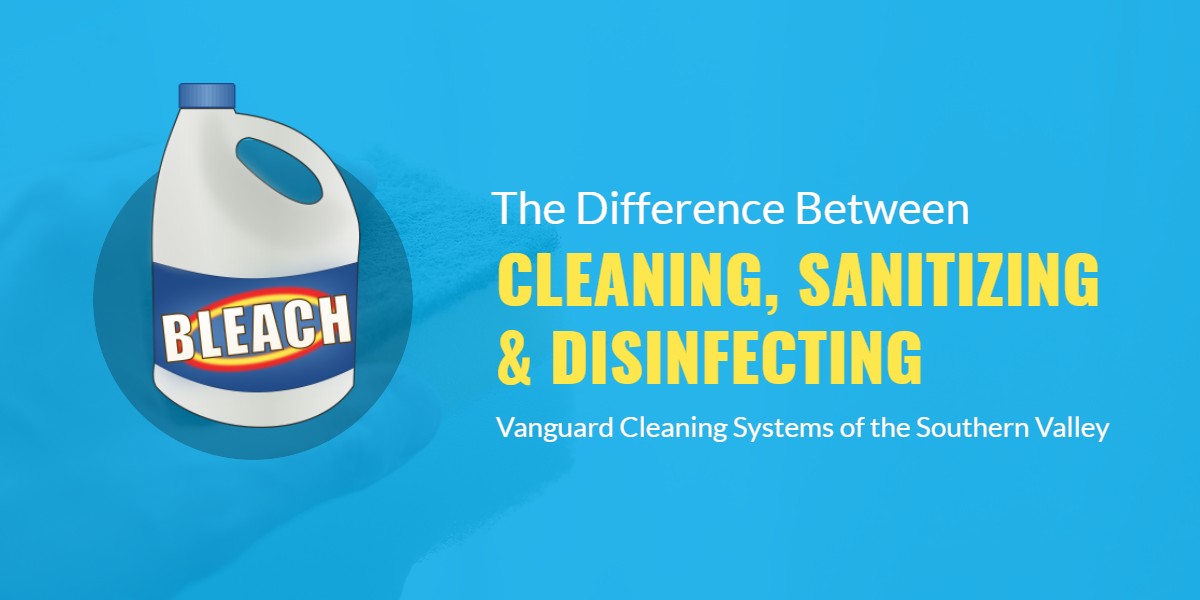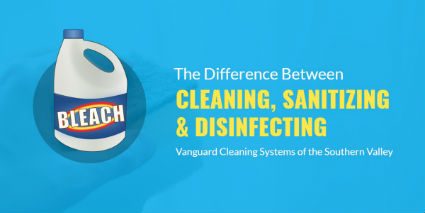Understanding the difference between cleaning, sanitizing, and disinfecting will help with product purchasing decisions and service scheduling.

What is the Difference Between Cleaning, Sanitizing, and Disinfecting?
Commercial cleaning chemicals should only be handled by trained professionals familiar with the proper procedures, as well as associated dangers and necessary precautions associated with toxic chemical handling.
The three most relevant challenges facing businesses in regards to chemical cleaner handling are:
- Selecting the correct product for the required task.
- Proper dilution, and;
- Training employees in the safe use and potential dangers of the products.
Product Selection
There is a significant difference between cleaning, sanitizing, and disinfecting.
Cleaning, by itself, is relatively ineffective at preventing the spread of germs.
However, disinfectants and sanitizers tend to have issues with effectiveness when it comes to dust and soil, which is why it is important to always clean before sanitizing or disinfecting.
Regular cleaning agents (liquids, powders, sprays, or granules) simply remove dirt, dust, debris and odors from surfaces.
Although this is an important first step in improving the health of an environment, it is not enough to stop the spread of disease.
Cleaners are often used to improve appearances.
They are not effective at killing bacteria or viruses.
- Cleaning removes dirt and odors but is relatively ineffective at reducing the number of surface bacteria and germs. Example: Vacuuming and dusting.
- Sanitizing removes 99.9% of surface microorganisms within 30 seconds but does not necessarily kill them. Example: Liquid hand sanitizer.
- Disinfectants kill 99.999% of surface microorganisms within 5 to 10 minutes. Example: Bleach.
Depending on the task, and the necessary level of clean required, based on the potential for human exposure to germs, as well as the cleaning chemicals themselves, it is of vital importance that the correct cleaning product is utilized.
Additionally, commercial disinfectants are classified by the U.S. Environmental Protection Agency as a pesticide and are too toxic to be used in schools or daycares where the possibility exists for a child to put something in their mouth, covered in the film of a poisonous cleaning agent, so it is essential to regulate and monitor what types of chemicals are used in specific environments.
Proper Dilution
Properly diluting cleaners, sanitizers, and disinfectants have several advantages, especially when combined with a chemical management system.
- Cost Reduction - Purchasing expenses are reduced by eliminating waste while simultaneously reducing management overhead.
- Health - Improperly diluted chemicals pose significant, long and short-term health risks.
- Efficiency - Time is no longer wasted assuming proper dilution or having to repeat tasks for insufficiently disinfected areas due to an improper mix.
- Management - Product volume, cost management, accounting, budgeting, and reporting are now possible, further reducing costs and simplifying facilities maintenance tasks.
Training
Staff training is, by far, the most critical challenge that must be met.
The success or failure of a cleaner, sanitizer or disinfectant is typically not related to the chemical composition of the product, but rather its proper use.
When cleaning staff doesn’t understand how to use the products correctly, mistakes happen.
The most important topics to address are:
- The safe handling and application of chemical cleaners, as well as what to do in the event of an emergency.
- Ensuring that appropriate dwell times are adhered to, depending on the product and task purpose.
- Recognizing the difference between the appearance of clean, and actually sanitized or disinfected surfaces.
- Focusing on cleaning before sterilizing or disinfecting to ensure it's full effectiveness.
References
Takeaway
With the proper training and product dilution, your organization will be able to significantly reduce product purchasing costs and employee absenteeism associated with toxin exposure or work acquired illness due to improper sanitizing or disinfection.
The simplest and most beneficial way to address the challenge of proper dilution is to implement a chemical management system.
Consulting with a professional green janitorial services vendor will significantly reduce the amount of time it takes for your organization to realize the full benefits of a properly managed chemical management and training program.
If you would like to learn more about the benefits of green commercial cleaning services for your school or business, contact us today for a free quote!
In Bakersfield CA, call (661) 395-3009
In Fresno CA, call (559) 473-1790

